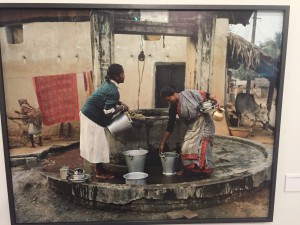Maylee Acevedo
Digital Photography
COMD 2330
Fall 2015
Since this was my first time walking into the Patrick Faigenbaum at the Aperture Gallery, I wanted to pay attention to details. Along my journey I realized that it’s a heavily industrial area with many different galleries, art, photographical, and sculptures. I am sure if I continued down the road I would have encountered a lot more interesting places I would go back to visit. If you aren’t introduced to places like this then no one will ever know places like this excited. This semester has introduced me to many different elements of art and I’m looking forward to learning more.
The build of the Aperture Gallery is very big and modern like, nice brick walls with a large table with different events available if interested. You then enter an elevator, to the 4 floor, as you step out you are greeted by a young lady with a smile “If you have any question please ask; enjoy the exhibit”. The gallery was pretty quiet not many people around other than the workers and ironically a classmate. The physical space was very bright nice tall dividers painted white, with remarkable photographs Faigenbaum has taken of Kolkata. To the right of the elevator an introduction to Faigenbaum time in Kolkata and the history of the countries up comings were displayed to understand the feeling of these photos.
I notice many different styles in Patrick’s photos when it comes to the city of Kolkata he photographed in black and white to emphasize the age of the city not in years yet to show how things haven’t changed in the new millennium. This is the feeling I received in his art. He’s photographs also captures hard working individual from morning through into the night, capturing eye level viewpoints, close ups, bird-eye view, and many more of the important techniques in grasping the viewers’ attention by telling its story.
The photograph I choose and don’t get me wrong I had a hard time picking which one I enjoyed the most. This photo was taken at an eye-level it had strong diagonal lines from the clothes line to the shed covering the cow. The rules of third captured and important part of the images and it’s the only wet area visibly seen surrounding the working ladies.
This is a medium framing shot we have enough of the scene to tell its story. When I look hard at the image the colorful clothing the women are dressed in stands out, because of the breaking pattern from the beige tone in the background also the dryness of everything surrounding the well. This image shows the struggle everyone has just to provide water for their homes, it also shows the lack of rain they receive because of the emotional dryness it shows just by looking at the brightness the water brings to the center of image. This image shows sadness to the viewer’s eye yet the daily living of these women who may not know it any other way. I for one will look at this picture and be grateful for what I have.
I enjoyed the Aperture gallery and grateful I had the chance to see something new and exciting having an understanding of the story images can tell and the emotions you can feel just by using one of our most important senses and that’s sight without it would could not see the amazing moments captured.





I agree that feeling grateful is logical response to this photo. These women live in a major urban center and yet must wash their dishes at a common well and carry water home. I cannot imagine living this way beyond a short trip. Yet the women do not look sad or abject. The environment looks worn but not filthy or disgusting. I think Faigenbaum’s attitude towards the women is one of respect. They are large in the frame and centrally placed. The one woman’s white dress is impeccably clean. This photo really gives us an entry into their daily lives.
One term I would not use for this photo is the rule of thirds. Here the important part of the photo is set in the center and in fact this helps keep our attention on these women as there are other people and animals around that could have been very distracting.